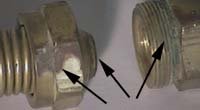Flexible Gas Connectors
Back to Consumers' Eye more info.
Flexible gas connectors are used to connect various movable appliances to a building's natural gas supply. Today these connectors are made of stainless steel but up until the late 1970s they were made of brass. (see Figure ,1 below.)
Figure 1. Top New stainless steel connector. Bottom older, faulty brass connector.
The ends of both tubes are attached at left and shown removed at right.
Many of the brass connectors have begun to corrode (see figure 2) and or the solder joint holding the nipple (figure 3) has begun to break down. Failures of these tubes have led to gas leaks, and explosions. Due to the potentially fragile nature of old brass connectors, consumers are urged to check for the existence of a brass connector without moving the appliance in question. This may sound strange, but minute cracks and leaks may develop in the hose later on. If you can't see the connector or have to move the appliance, Call the gas company or a licensed plumber to inspect and or replace your connectors. New connectors have the metal tube flared on each end (figure 4). On a stainless steel hose, once the nut on the connector is tightened (figure 1 left) the flared end of the hose, instead of the nipple is pressed up against the pipe or gas hookup eliminating the nipple and failure prone solder joint. Figure 5 shows the nuts (left) and the threads they screw onto (right). Note the absence of a nipple on the stainless steel connector on top.
Figure 2
This connector is still shiny, but
inside it has hidden corrosion.
Figure3
The soldered-on nipple
Figure 4
Stainless steel connector nipple.
Figure 5
Connectors as they attach to pipe/appliance
Where Flexible Connectors are allowed:
Flexible connectors are commonly found on clothes dryers, stoves and ovens. As a general rule they are used on gas powered appliances that may need to be moved for service or cleaning. When you purchase a new stove or dryer the dealer of that appliance is required by law to provide a new flexible gas connector. New connectors will have a permanently attached metal ring (see fig. 1 left hand side, the one on top happens to be copper colored, the one on the bottom is silver) that gives information about the manufacturer, the lot/part numbers and a stamp of approval. If the connector looks damaged, or is missing the metal ring don't purchase it or refuse to have it installed. Flexible connectors are only to be used to connect moveable appliances. Stationary appliances such as furnaces, boilers, space heaters, and water heaters must be connected by rigid pipe only, usually black iron. Flexible connectors may only be used where they will not be subject to bending, pinching or vibration. They must begin and end no more than 6 feet from a shut of valve which must be located in the same room. The entire length of hose must be exposed and accessible for inspection and replacement, That means they may not pass through walls ceilings or floors. They also may not be used in place of normal gas lines, i.e. from the meter to the kitchen shutoff valve. Only the shortest possible connector should be used as this cuts down the likelihood of the connector being damaged. Do not paint flexible gas connectors as the paint may cover up visible damage or lead to corrosion. Flexible connectors and whatever kind of rigid pipe your local jurisdiction allows are the only kind of pipes that should ever be used. They conform to strict standards and are tested and approved.
When to replace all types of flexible connectors
If any flexible connector is bent excessively, kinked, corroded or over ten years old, it should be replaced. It's much safer to replace suspicious connectors than to try to repair them. Do not reuse old gas connectors even if they appear to be in good shape.
If you smell gas
If you smell gas, all pilot lights in the area are lit and you don't know the source of the leak and or can't shut off the gas, quickly do the following, seconds count.
1. Do not touch electrical appliances (that includes light switches and fans), do not attempt to dial a telephone near the gas leak. You may not be able to see them, but tiny sparks occur that can cause an explosion.
2. Extinguish all smoking materials and open flames.
3. Open windows and doors
4. Evacuate
5. Call 911 and report the leak.
Legal issues:
This document is for informational purposes only. It is not intended as a how to on gas plumbing and it does not contain information on testing for gas leaks or repairing/replacing gas piping. Any work you do, is done at your own risk. If you are unsure of what to do (changing the connector is not as simple as screwing in a new one) stop. Call a licensed plumber to do or finish the work. You not only are at the risk of injuring yourself and damaging your property you also put others at risk as well. The Consumers's Eye accepts no responsibility for damages and or injuries resulting from the use/misuse of this document. For further information please contact your gas supplier




